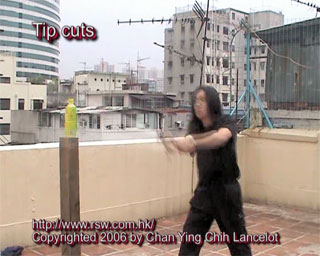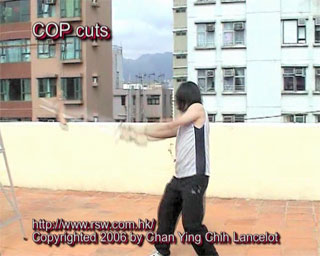

- Freestyle fencing with the historical arsenal
Lancelot's review of Angus Trim 1561 longsword
by Lancelot Chan
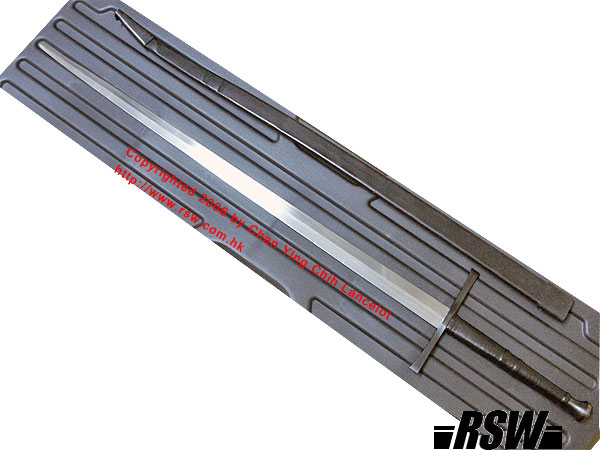
Photographic Review, Dry Handling and General Description
Angus Trim
1561 was a longsword of European style inspired by the original swords from
15th Century. The sword's size fit me perfectly. The length of the hilt was
3 hand-span for me while the overall length reaches my solar plexus. The
only thing I would like to have is a crossguard as long as the hilt, as
suggested in Guy Windsor's book Swordsman Companion. The seam on the hilt
was fine and the grip fit my hands very well. I did not have to wear gloves
in handling this sword. These were the major reasons I purchased the sword
right away. The sword was quick and light, just like my
spadona. In fact, they handled very
similarly. Where the spadona was heavier
overall with a closer-to-hilt balance, the AT1561 had a lighter overall
weight but a stronger blade presence. It did not take any time for me to
adapt the AT1561, at least that was what I thought until the first test cut
session. The sword followed the point very well in thrusting. It was also
easy to accelerate and stop in cutting motion. Combined with its fine edge
geometry, lightweight and relatively high flexibility, even the narrow blade
did offer option in half-swording, though, one could not argue that this was
a sword designed for unarmored combat.
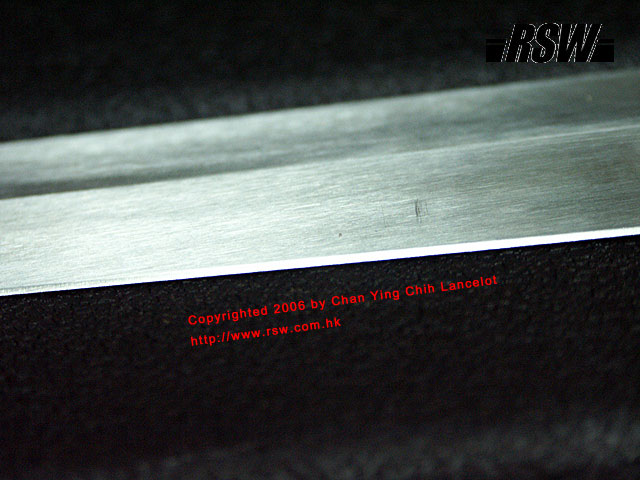
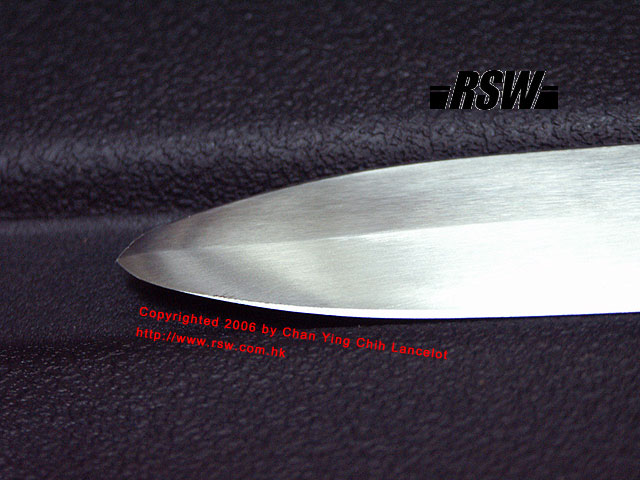
The stock-edge with this sword had a fine geometry and the edge lines had almost no dull spots below the forte. In fact, the other two swords that I ordered with fine edges had more dull spots than the review sword. It could be that in the process of producing the finer edge geometry, the edge lines were not taken care of to the same degree. Nevertheless, I was impressed by the edges geometry of all the three swords I received. They were now on par with the tinker sword's edges I used to have and without doubt, a significant improvement over the old Angus Trim swords I had handled. The edge lines were undulating but would not affect the functionality. Also, it did not stray away from the utilitarian style.
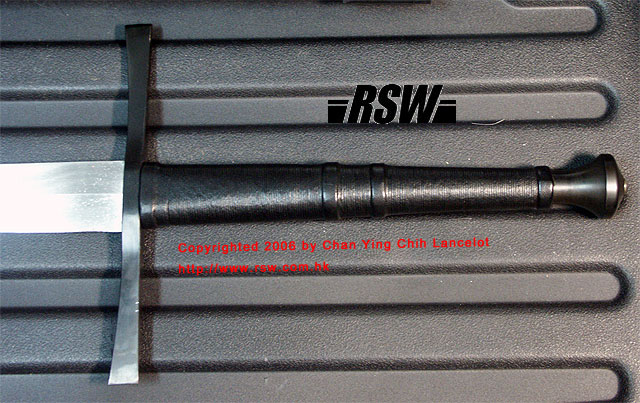
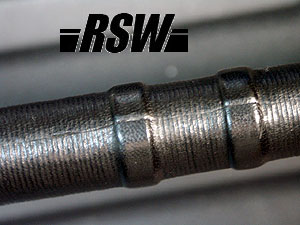
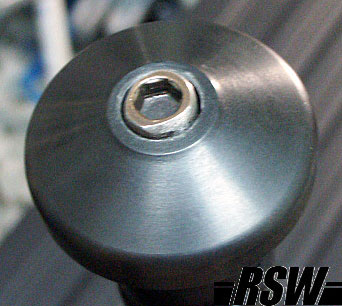
I also like the blackened hilt components so I would be less worrying about stain and rust.
Soft Targets Test Cutting
I performed
two test cutting sessions with the stock-edge on water bottles with this
sword. I did not video tape the first sessions but I can honestly tell you
that it made me embarrassed in front of my friends. Having cut a lot with
the spadona had made me over-confident. To
my surprise, my first cut shot the bottle down the street in one piece.
Damn. I soon realized that I had to readjust my grip since the grip of this
sword was bulkier than the grip of the spadona.
Once I had done that, I had no problem in blade alignment and could do an
honest evaluation, thus I video taped the second test cutting session.
In the second test cutting session, I learned another lesson. While I could
produce very accurate and fancy, short ranged cuts with the
spadona, this sword required a significant
different aim, perhaps due to the more uniform distal tapering, or the
increased length, or both. The slight difference in the grip magnified to an
inch of difference at the tip. That was how I ended up hitting the wooden
pole twice, embarrassing myself in front of the audiences again. The sword
edge showed only one dot of light after the accidents, though. Tough it was!
At the end, some cuts were smoother than the others. The smooth downward
cuts' feeling was comparable to my spadona's
cuts and a lot better than most swords I had handled in this price range.
All the upward cuts penetrated the bottles slightly only. Tip cuts worked
better with the soft targets than COP cuts because the latter produced more
shock and resistance, which was observable by the distance the bottles flew
away. This also showed that the sword performed a lot better in tip cutting
than the old Gus Trim swords years ago. Nevertheless, I experienced no
vibrations in my hands. One could say the sword was not as forgiving as some
with the wider blade but to me it cut sufficiently well, even before I
touched up the edges.
Since there were dull spots on the edges, I tried to avoid evaluating the
edge holding ability of the sword after cutting the water bottles. After
all, it would be very difficult to differentiate which dull spots were
caused in the cutting and which were original. However, I would evaluate
this after I touched up the edges to clean up all dull spots.
After cleaning up the dull spots on both edges, I proceeded to test cut
again on water bottles and video taped the result. I found that the
performance was not improved much over the last test cutting, showing that
the in-stock edge lines were more or less pristine after all and the
occasional dull spots did not have much effects on the cuts. Against harder
bottles like the coca cola ones, the cuts sometimes just bounced the bottle
off. Yet, most of the downward cuts were successful, and I managed to pull
off one false edge downward cut successfully on a soft bottle.
On the same day we had test cut with the
spadona and the atrim1572 long saber with fine edge. It was obvious that
the at1561 with the in stock edge was having more difficulty in dealing with
the soft target compare to the two swords, yet also suffered less dulling in
the test cutting. In fact, it was almost unnoticeable with bare eyes. It
would seem that the AT1561 would fare better than both the swords in edge
retention against harder target like pork arm.
Hard Targets Test Cutting
First I would like to make it clear that the pork arm was tougher than the
human arm of the equivalent size, be it dead or alive. The skin was thicker,
more difficult to slice through. The fat was more and the bone was sturdier.
Even the fingers and nails were much tougher than the human's. Plus, in the
test cutting session the pork arm was hung by a string, giving a lot of room
to give away from the impact force. So if the pork arm was stuck to a body
weighting over 150 lbs, the cut would go much deeper. As a conclusion, all
the results demonstrated in the test should be magnified to a certain degree
if it was performed in an actual combat where a human body was hit in a
similar way.
According to my pork arm cutting experience, taking into account that the
design of AT1561 was a light, fast cut and thrust long sword for unarmored
combat, it had performed very well as one can see in the video. All the COP
cuts went very deep and later on, after the majority of the target's mass
was removed, the tip cuts still penetrated deeply into the bone. So if it
was a human target with the body mass backing up, I had no doubt that the
sword's COP cuts would remove a limb where the tip cuts would be disabling.
After the test cutting, I brought the sword back to my special lighting room
where I could view the edges very carefully and detect any slight dullness.
The sword performed very well on the edge retention aspect where there was
no noticeable dulling. The edges stood well against this demanding test!
Stiffness Testing
While the sword had a relatively high flexibility, gripping it with two
hands and tapping the flat side against a mobile chair showed that it was
still reliable to parry with the flat. Unless the stress happened on the tip
portion, where a parry should not be made after all, the blade did not seem
to be flexing far enough to make me worry. In fact, when tapping the middle
portion to the forte of the sword against the chair, the chair was simply
moved around without the blade vibrating much. Tapping the middle part of
the blade or forte against an immobile target with moderate force showed a
stiff response. It was observable that the flex was a bit more than the
spadona in the middle of the blade to the
forte, as the distal taper was more uniform than the
spadona. However, there was a huge price
difference between the two swords as well. So I would say the design of the
sword worked well in both offense and defense.
Specifications and Final Words
Overall length: 47.25"
Blade length: 36"
Blade width at base: 1.625"
Blade width at tip: 0.5"
Blade thickness at base: 6mm
Blade thickness at tip: 2mm
Guard width: 8.25"
Hardness: Between 50 and 55 HRC
Weight: 2 lbs 9 oz
Balance: 5" down the guard
AT1561 featured several improvements over its predecessors. First of all,
the grip was leather wrapped with cord beneath, providing more gripping
power than the wooden surface of the old Atrim's grip. Secondly, the hilt's
shape tapered less so that it fit both of my hands better, while still
allowing me to change my grip easily during action. Thirdly, the components
were blackened and became rust resistant, fitting its utilitarian design.
Fourthly, the edges were much finer than its predecessors with the geometry
comparable to Tinker's level, even if the edge lines could have some dulled
spots (very few in this review's sword case). Moreover, even though Gus paid
a lot attention to COP cutting in the past, the tip cutting ability was not
ignored in this sword. With such a narrowed tip, I did not expect it cut
that well. In addition, I used to doubt Gus' approach in balancing a sword
further out, like 5 inches or more down the guard, but with a lighter
overall weight. After testing this sword, I had no more doubt in this
design's functionality. The edge retention ability was impressive too. While
not among the almost magical retention that I had seen on
Martial Art Sword Sun Flower Classic,
it was performing very well in its price range, perhaps the best. The edge
geometry was a design to handle both water bottles and pork arm cutting and
it did the job perfectly. It would not win the soft target cutting contest
against the finer edged swords, but it would cut the hard target very deeply
without suffering visible damage. In my opinion, for the price of the sword
it had proved itself worthy for every dollar as a utilitarian sword for WMA
practitioner that would last long enough through repetitive cutting
practices.
